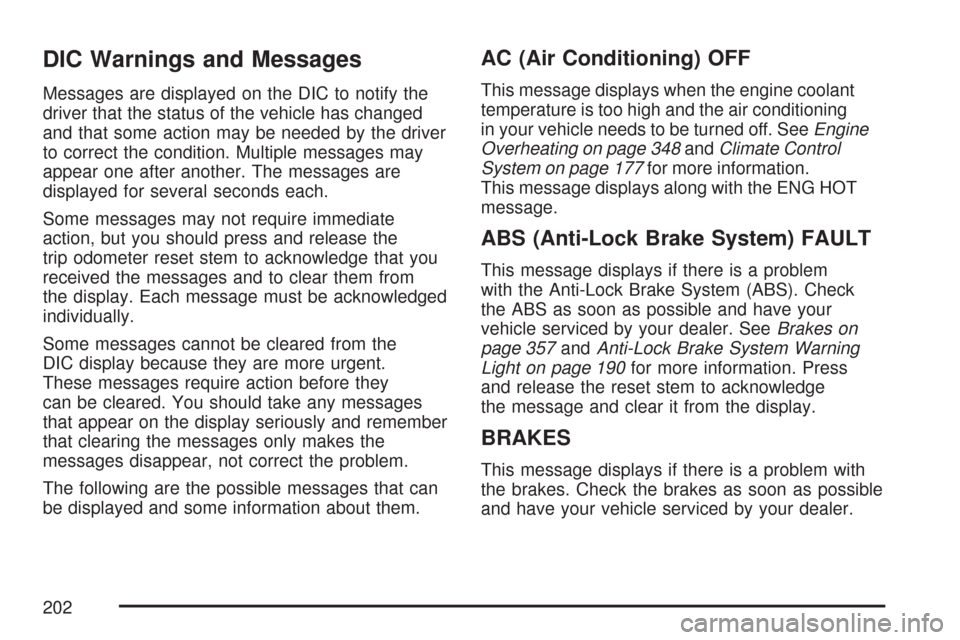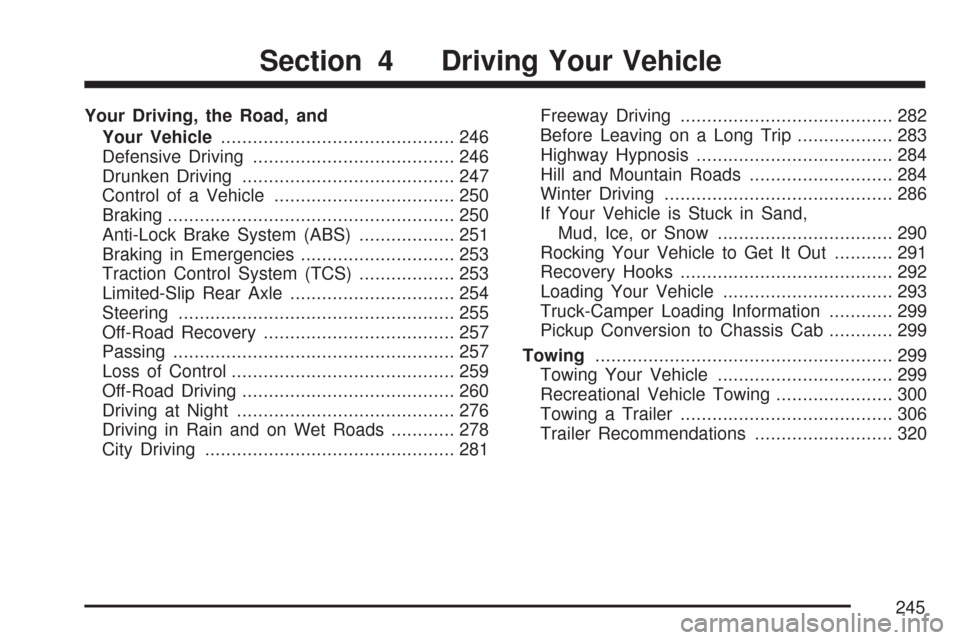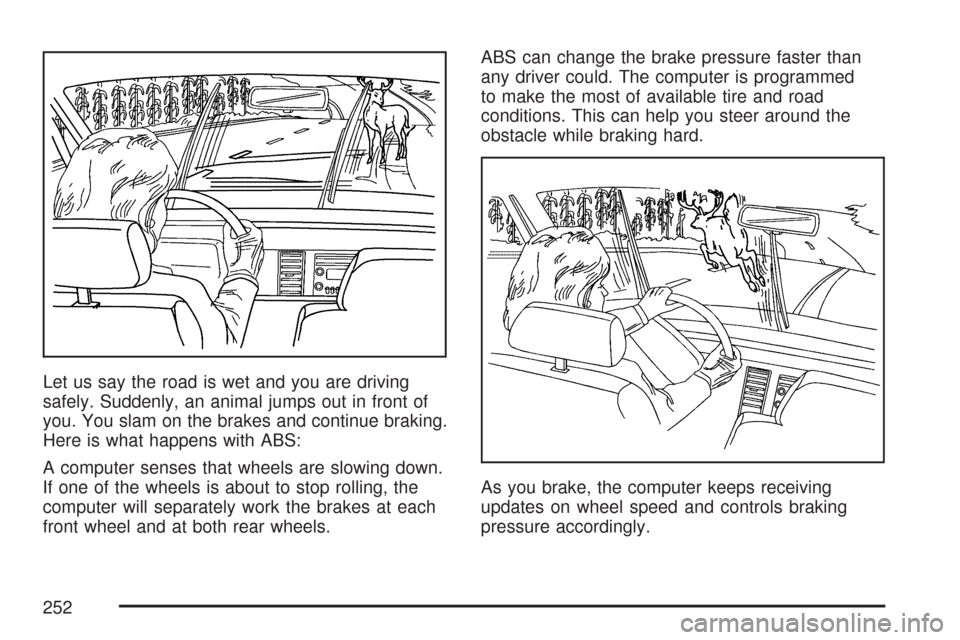2007 CHEVROLET COLORADO ABS
[x] Cancel search: ABSPage 190 of 496

When the ignition is on, the brake system warning
light will also come on when you set your parking
brake. SeeParking Brake on page 133for more
information. The light will stay on if your parking
brake does not release fully. If it stays on after your
parking brake is fully released, it means you have a
brake problem.
If the light comes on while you are driving, pull off
the road and stop carefully. You may notice that the
pedal is harder to push, or the pedal may go closer
to the �oor. It may take longer to stop. If the light
is still on, have the vehicle towed for service.
SeeTowing Your Vehicle on page 299.
{CAUTION:
Your brake system may not be working
properly if the brake system warning light
is on. Driving with the brake system
warning light on can lead to an accident.
If the light is still on after you have pulled
off the road and stopped carefully, have
the vehicle towed for service.
Anti-Lock Brake System
Warning Light
With the Anti-Lock Brake
System (ABS), this light
will come on brie�y when
you start your engine
to show it is working.
Then it will turn off.
This is normal.
If the light stays on, or comes on when you are
driving, your vehicle needs service. If the regular
brake system warning light is not on, you still
have brakes, but you do not have anti-lock brakes.
If the regular brake system warning light is also
on, you do not have anti-lock brakes and there is
a problem with your regular brakes. SeeBrake
System Warning Light on page 189.
The ABS warning light should come on brie�y
when you turn the ignition key to ON. If the light
does not come on then, have it �xed so it will
be ready to warn you if there is a problem.
190
Page 202 of 496

DIC Warnings and Messages
Messages are displayed on the DIC to notify the
driver that the status of the vehicle has changed
and that some action may be needed by the driver
to correct the condition. Multiple messages may
appear one after another. The messages are
displayed for several seconds each.
Some messages may not require immediate
action, but you should press and release the
trip odometer reset stem to acknowledge that you
received the messages and to clear them from
the display. Each message must be acknowledged
individually.
Some messages cannot be cleared from the
DIC display because they are more urgent.
These messages require action before they
can be cleared. You should take any messages
that appear on the display seriously and remember
that clearing the messages only makes the
messages disappear, not correct the problem.
The following are the possible messages that can
be displayed and some information about them.
AC (Air Conditioning) OFF
This message displays when the engine coolant
temperature is too high and the air conditioning
in your vehicle needs to be turned off. SeeEngine
Overheating on page 348andClimate Control
System on page 177for more information.
This message displays along with the ENG HOT
message.
ABS (Anti-Lock Brake System) FAULT
This message displays if there is a problem
with the Anti-Lock Brake System (ABS). Check
the ABS as soon as possible and have your
vehicle serviced by your dealer. SeeBrakes on
page 357andAnti-Lock Brake System Warning
Light on page 190for more information. Press
and release the reset stem to acknowledge
the message and clear it from the display.
BRAKES
This message displays if there is a problem with
the brakes. Check the brakes as soon as possible
and have your vehicle serviced by your dealer.
202
Page 245 of 496

Your Driving, the Road, and
Your Vehicle............................................ 246
Defensive Driving...................................... 246
Drunken Driving........................................ 247
Control of a Vehicle.................................. 250
Braking...................................................... 250
Anti-Lock Brake System (ABS).................. 251
Braking in Emergencies............................. 253
Traction Control System (TCS).................. 253
Limited-Slip Rear Axle............................... 254
Steering.................................................... 255
Off-Road Recovery.................................... 257
Passing..................................................... 257
Loss of Control.......................................... 259
Off-Road Driving........................................ 260
Driving at Night......................................... 276
Driving in Rain and on Wet Roads............ 278
City Driving............................................... 281Freeway Driving........................................ 282
Before Leaving on a Long Trip.................. 283
Highway Hypnosis..................................... 284
Hill and Mountain Roads........................... 284
Winter Driving........................................... 286
If Your Vehicle is Stuck in Sand,
Mud, Ice, or Snow................................. 290
Rocking Your Vehicle to Get It Out........... 291
Recovery Hooks........................................ 292
Loading Your Vehicle................................ 293
Truck-Camper Loading Information............ 299
Pickup Conversion to Chassis Cab............ 299
Towing........................................................ 299
Towing Your Vehicle................................. 299
Recreational Vehicle Towing...................... 300
Towing a Trailer........................................ 306
Trailer Recommendations.......................... 320
Section 4 Driving Your Vehicle
245
Page 251 of 496

Avoid needless heavy braking. Some people
drive in spurts — heavy acceleration followed
by heavy braking — rather than keeping pace
with traffic. This is a mistake. The brakes may
not have time to cool between hard stops.
The brakes will wear out much faster if you do
a lot of heavy braking. If you keep pace with the
traffic and allow realistic following distances,
you will eliminate a lot of unnecessary braking.
That means better braking and longer brake life.
If your vehicle’s engine ever stops while you
are driving, brake normally but do not pump the
brakes. If you do, the pedal may get harder
to push down. If the engine stops, you will still
have some power brake assist. But you will use
it when you brake. Once the power assist is
used up, it may take longer to stop and the
brake pedal will be harder to push.
Adding non-GM accessories can affect your
vehicle’s performance. SeeAccessories and
Modi�cations on page 324.Anti-Lock Brake System (ABS)
Your vehicle has the Anti-Lock Brake System
(ABS), an advanced electronic braking system
that will help prevent a braking skid.
When you start the engine and begin to drive
away, ABS will check itself. You might hear
a momentary motor or clicking noise while this
test is going on. This is normal.
If there is a problem
with the ABS, this
warning light will stay
on. SeeAnti-Lock Brake
System Warning Light
on page 190.
251
Page 252 of 496

Let us say the road is wet and you are driving
safely. Suddenly, an animal jumps out in front of
you. You slam on the brakes and continue braking.
Here is what happens with ABS:
A computer senses that wheels are slowing down.
If one of the wheels is about to stop rolling, the
computer will separately work the brakes at each
front wheel and at both rear wheels.ABS can change the brake pressure faster than
any driver could. The computer is programmed
to make the most of available tire and road
conditions. This can help you steer around the
obstacle while braking hard.
As you brake, the computer keeps receiving
updates on wheel speed and controls braking
pressure accordingly.
252
Page 253 of 496

Remember: ABS does not change the time
you need to get your foot up to the brake pedal
or always decrease stopping distance. If you
get too close to the vehicle in front of you,
you will not have time to apply the brakes if that
vehicle suddenly slows or stops. Always leave
enough room up ahead to stop, even though
you have ABS.
Using ABS
Do not pump the brakes. Just hold the brake
pedal down �rmly and let anti-lock work for you.
You might feel the brakes vibrate or notice
some noise, but this is normal.
Braking in Emergencies
With ABS, you can steer and brake at the same
time. In many emergencies, steering can help
you more than even the very best braking.
Traction Control System (TCS)
Your vehicle may have a Traction Control
System (TCS) that limits wheel spin. This is
especially useful in slippery road conditions.
The system operates only if it senses that
one or both of the rear wheels are spinning or
beginning to lose traction. When this happens,
the system reduces engine power and may
also upshift the transmission to limit wheel spin.
You may feel or hear the system working,
but this is normal.
The TCS button is
located on your
instrument panel.
Press this button
to turn the TCS
off and on.
When the traction control system is turned off,
an indicator light on the button will illuminate.
253
Page 260 of 496

The three types of skids correspond to your
vehicle’s three control systems. In the braking skid,
the wheels are not rolling. In the steering or
cornering skid, too much speed or steering in a
curve causes tires to slip and lose cornering force.
And in the acceleration skid, too much throttle
causes the driving wheels to spin.
A cornering skid is best handled by easing your
foot off the accelerator pedal.
If your vehicle starts to slide, ease your foot off
the accelerator pedal and quickly steer the
way you want the vehicle to go. If you start
steering quickly enough, your vehicle may
straighten out. Always be ready for a second skid
if it occurs.
Of course, traction is reduced when water, snow,
ice, gravel, or other material is on the road. For
safety, you want to slow down and adjust your
driving to these conditions. It is important to slow
down on slippery surfaces because stopping
distance is longer and vehicle control more limited.While driving on a surface with reduced traction,
try your best to avoid sudden steering, acceleration,
or braking, including reducing vehicle speed by
shifting to a lower gear. Any sudden changes could
cause the tires to slide. You might not realize the
surface is slippery until your vehicle is skidding.
Learn to recognize warning clues — such as
enough water, ice, or packed snow on the road
to make a mirrored surface — and slow down when
you have any doubt.
Remember: Any Anti-Lock Brake System (ABS)
helps avoid only the braking skid.
Off-Road Driving
This off-road guide is for vehicles that have
four-wheel drive. Also, seeBraking on page 250
andAnti-Lock Brake System (ABS) on page 251.
If your vehicle does not have four-wheel drive,
you should not drive off-road unless you are on
a level, solid surface.
260
Page 288 of 496

Accelerate gently. Try not to break the fragile
traction. If you accelerate too fast, the drive wheels
will spin and polish the surface under the tires
even more.
The Anti-Lock Brake System (ABS) improves your
vehicle’s stability when you make a hard stop
on a slippery road. Even though you have ABS,
you will want to begin stopping sooner than
you would on dry pavement. SeeAnti-Lock Brake
System (ABS) on page 251.
Allow greater following distance on any
slippery road.
Watch for slippery spots. The road might
be �ne until you hit a spot that is covered
with ice. On an otherwise clear road, ice
patches may appear in shaded areas where
the sun cannot reach, such as around clumps
of trees, behind buildings, or under bridges.
Sometimes the surface of a curve or an
overpass may remain icy when the
surrounding roads are clear. If you see a
patch of ice ahead of you, brake before
you are on it. Try not to brake while you
are actually on the ice, and avoid sudden
steering maneuvers.
If You Are Caught in a Blizzard
If you are stopped by heavy snow, you could
be in a serious situation. You should probably
stay with your vehicle unless you know for
sure that you are near help and you can hike
through the snow. Here are some things to do
to summon help and keep yourself and your
passengers safe:
Turn on your hazard �ashers.
Tie a red cloth to your vehicle to alert police
that you have been stopped by the snow.
Put on extra clothing or wrap a blanket
around you. If you do not have blankets
or extra clothing, make body insulators
from newspapers, burlap bags, rags, �oor
mats — anything you can wrap around
yourself or tuck under your clothing to
keep warm.
288